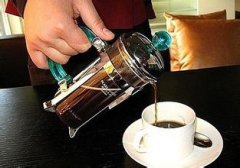It is very important to make Espresso bean grinder.

Why is the bean grinder so important-
The reason is based on the way espresso operates:
The water pressure is very high and the cooking time is very short.
Cooking time-
The so-called "brewing time" refers to the time it takes for hot water to penetrate coffee powder. Ideally, the time for high-pressure hot water to contact coffee powder is about 25 to 28 seconds. In such a short time, water-soluble aromatic substances are not allowed to dissolve slowly. It takes a long time to use trickling or French filter press, which takes 3 to 5 minutes.)
With the method of cooking for a long time, a cheap propeller bean grinder is enough. And the espresso cooking method is fast and fierce, there is no room for mistakes, the need for more accurate grinding. The position of the bean grinder is very important. after the beans are torn into powder, the tangled surface of these particles greatly increases the overall surface area, and hot water can easily evenly extract the maximum concentration of delicious coffee oil.
High pressure water-
Modern espresso machines with rotary pumps can produce a water pressure of 125lbs (the equivalent of 9 atmospheres). The compacted coffee filter cake is less than half an inch thick, but it has to bear so much pressure, and the first task of the bean grinder is to make the ground coffee powder have a balanced resistance.
As I mentioned earlier, water always "falls off" from the way with the least resistance, and it doesn't care about your dream of "making the perfect coffee". But after the beans are properly ground, the current will obediently obey.
To understand the complexity of this, you'd better look at a microscope picture of the coffee powder. (thanks to Mr. Dan Hallett of Swedish Hospital in Seattle for his assistance) (WebBarista Note: of course, the picture is only in the original book, but I'm sorry I can't change it.)
The sharp blade of the commercial bean grinder can evenly tear the beans into irregular polygonal space shapes, which provides the maximum contact surface area, where hot water and aromatic oils converge, so the most delicious substances can be extracted in 25 seconds. On the contrary, the bad substances and caffeine do not have the opportunity to flow out in large quantities, and this is the difference between the good and the bad of espresso.
After the blade is blunt, the ground particles will turn into clumps of powder of irregular size. Such a short cooking time, hot water can not fully penetrate into the big powder ball, resulting in insufficient extraction. Too small balls of powder can be overextracted, dissolving bitter and slightly alkaline substances (as is the case with propeller grinders), and it is impossible to cook perfect espresso in this way.
Bean grinder blade-
What kind of bean grinder can make uniform grinding? The conditions are as follows:
1. The rotating speed of the blade should be low, and the thickness can be adjusted.
two。 In the practical adjustment range of the bean grinder, the grinding teeth should be absolutely parallel.
3. The thickness adjustment mechanism must be able to be tuned almost endlessly.
4. The drive motor should be "rough" so that it will not overheat.
5. The manufacturer must provide spare grinding pieces, and it is easy to replace.
6. The heat generated inside the bean grinder should be discharged by means of forced ventilation.
7. Do not choose the bean grinder directly driven by the motor shaft, use the belt indirect drive way, can avoid the heat transfer of the motor to the blade.
Many bean grinders use a grid to adjust the thickness, and there are pointers or indicators on the dial. When the blade is worn, the gap between the blades becomes larger, and the original thickness is not correct. As long as these machines are adjusted a little, the extraction time will change by 5 to 10 seconds. A skilled bar can make more fine adjustments (see Chapter 16 of this book: adjusting the degree of grinding).
There are two kinds of bean sharpener-
1. Flat (or "parallel") blade
two。 Conical blade
It is generally believed that the tapered blade is better because its cutting edge is longer, so the rotational speed can be reduced, which reduces the damage of grinding heat to beans. No matter what the principle causes the difference, according to my personal experience, tapered blades are better (we think parallel / tapered blades are the best) because the boiled espresso is thicker, sweeter and larger. There will be no "machine smell" mixed into the coffee.
The commercial bean grinder has the advantages of strong horsepower, low rotational speed, precise structure, good blade parallelism, will not heat the coffee, and the thickness can be precisely fine-tuned, so the price is high.
The blade should be sharp-
Everyone knows that I have been nagging, saying "the blade of the knife is blunt" over and over again. In fact, my nagging is reasonable, because the blade has a fixed service life. Usually the parallel blade can grind up to 600lbs of beans and the tapered blade can grind up to 2000 lbs.
Changing the parallel blade for every 600 beans grinds certainly hurts the cost. But after doing so, beans will love you and guests will love you.
After the blade is blunt, the texture of the espresso becomes thinner and the boiled cup becomes smaller. But don't forget that in order to find out the real cause of espresso deterioration, you must first control other factors. For example, whether the beans are not fresh or the blade is blunt, the boiled espresso is exactly the same!
When changing the blade, clean the knife holder first. The action of the locking screw should be applied evenly and locked slowly. The powder attached to the screw teeth is cleaned with a blade or sharp awl, not oiled, and the small steel brush is also easy to use.
The method in my shop is still not ideal.
The dose distributor of the Espresso special bean grinder can hold up to 200g coffee powder and rotate the fin leaves through the ratchet drive unit to send out the appropriate dose of coffee powder. "answer!" One sound means a single dose. "answer! answer!" Two tones, indicating a double dose.
There is a problem with this design: the coffee powder of the distributor must be at least half full before the quantity will be accurate. But the freshness of the coffee powder in it is ruined. Don't forget that the freshly ground powder will oxidize as soon as it comes into contact with air. If you leave it a little longer, the fragrance will be lost.
The method in our shop is: "grind only one cup at a time". When pouring out the coffee powder, knock on the machine five or six times and let the powder fall off. But the distributor breaks down quickly, and the rotating fin leaves mix the air with the coffee powder. It is better to have an airtight exit ramp.
There is also something wrong with our method, which only grinds one cup at a time, constantly turns on and off, harms the motor and produces a lot of heat. We use a non-commercial bean grinder (itself is not used for a large number of grinding). Every time we start the motor, the capacitor discharge circuit will heat up, and the movable parts of the switch and distributor are very expensive and often need to be replaced, which is troublesome. You have to bring your own inventory of related parts.
The heat generated by grinding beans will continue to accumulate, about 10 o'clock in the morning, after grinding 15 pounds of beans, the powder will feel warm. Originally cooked early in the morning two ounces of thick delicious espresso due to the heat of the coffee powder, oil is seriously damaged, the texture slowly thinner, taste worse, but also become relatively small cup.
I am glad to announce here that the problem of "hot" is solved! We installed a mute cooling fan on the back of the bean grinder. As long as the fan is plugged in, the fan will start. No matter how much you grind, the bean grinder won't get hot. (note: the fan will inhale fine powder and use a vacuum cleaner once a week.)
If you also plan to use my method of forced ventilation to dissipate heat, remember to find a professional mechanic to help you open the vents. Install fans and find professional electricians for wiring. The Espresso bar is a very professional place of business. Guys who like DIY should rein in and don't mess with themselves.
Important Notice :
前街咖啡 FrontStreet Coffee has moved to new addredd:
FrontStreet Coffee Address: 315,Donghua East Road,GuangZhou
Tel:020 38364473
- Prev

The best coffee is made by pressing a pot.
If Schultz makes his own coffee with an one-pound package of Starbucks beans that costs about $14, it costs about 46 cents per cup of coffee, while consumers spend $2.01 at a Starbucks store in Manhattan to buy a small cup of American coffee. Starbucks CEO Schultz pointed out in an interview with BusinessWeek a few days ago that the French kettle can remove various oils in coffee.
- Next

The simple eight steps teach you to make the same beautiful pull coffee as in the store.
La Hua Coffee, when it first came out, attracted the attention of the public with its magical and gorgeous techniques.
Related
- What is the meaning of lactic acid fermentation with coffee bean treatment?
- How to judge the state of foam by sound?
- How does the latte pull out the unicorn pattern? Come to get for a little trick to improve the flower pull!
- Will flower pulling affect the taste of the latte?
- Do you know the history of coffee?
- The difference between honey treatment and sun washing what is raisin honey treatment?
- What kind of milk can a novice use to make coffee foam to keep the foam longer? The correct method and skills of milking tutorial sharing
- Why do washed coffee beans taste sour? Flavor characteristics of washed Coffee
- Introduction to the skill of how to practice the size and height of water injection around the circle of hand-brewed coffee
- How do beginners practice coffee flower drawing from scratch?

